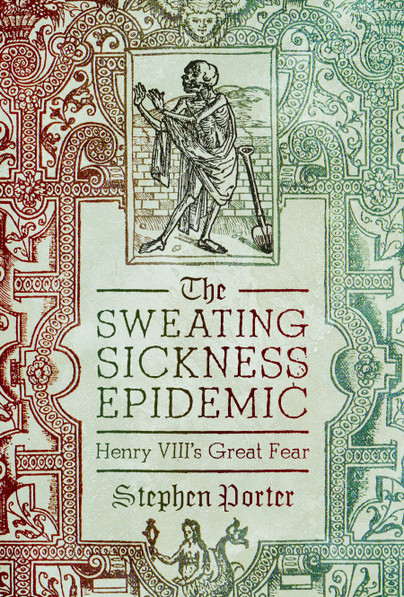The Sweating Sickness Epidemic (Hardback)
Henry VIII's Great Fear
Imprint: Pen & Sword History
Pages: 160
Illustrations: 40 mono illustrations
ISBN: 9781399064286
Published: 1st June 2023
(click here for international delivery rates)
Need a currency converter? Check XE.com for live rates
| Other formats available - Buy the Hardback and get the eBook for £1.99! | Price |
|---|---|
| The Sweating Sickness Epidemic eBook (7.3 MB) Add to Basket | £6.99 |
Among the array of diseases which brought death to Tudor England, the sweating sickness stood out, for the speed with which it struck, its dreadful effects on its victims and the death rates which it produced, that together generated a fear verging on panic when it was identified. The sweating sickness attacked the cities, towns and the countryside, not sparing the palaces. It threatened everyone, from the king in his castle to the beggars at his gates, including members of the dynasty and the political structure, the courtiers and those who directed the government, the church and the law. Contemporaries could do little more than make a bolt for it, and that included the king and his closest advisors, who moved furtively in a small group from one house to another away from London. The principal epidemics came between 1485, when it made its first appearance, and 1551, and it was confined to England and Wales, apart from one major eruption across northern Europe in 1529. Known as the English disease, this rapidly acting virus became Henry VIII’s overriding fear, aggravating his well-known hypochondria and controlling his movements.
The nature of the sweating sickness, its incidence and impact are all examined in this book, in the context not only of Tudor England and the problems of the Henrician succession, but also in the context of epidemic disease in Europe more widely. This book teases out the similarities and differences between ‘the sweat’ and its better-known, if equally feared, contemporary infectious disease, bubonic plague.
Typically when you read books about the Tudors, the Sweating Sickness is always lurking, mentioned in varying amounts of detail depending on who it is impacting, when it pops up time and time again with no rhyme or reason. Hundreds or thousands are carried off at any given time and then it is gone as quickly as it appeared.
NetGalley, Sarah Mueller
The Sweat might truly have been as, if not more, terrifying as The Plague. Of all of the diseases that those living in Tudor times, and through Henry VIII's reign in particular, had to deal with, it was the most mysterious. It remains that way today. We know almost nothing about it, what caused it first in 1485, why it struck England and Wales ALMOST exclusively, and why it nearly completely disappeared after the last major outbreak in 1551 during Edward VI's short reign.
Anyone familiar with the Tudors knows that Henry VIII was a big ol' baby and massive hypochondriac. At the first sniffle or sneeze, he was off from London to the supposed safety of the countryside. Yet the Sweat was something he rightly feared, as it would cross all class boundaries and no one was safe, no matter the precautions they were able to take due to their wealth or lack of it. In the times where the disease was ravaging England, Henry would reduce his household and move only with the most necessary of men needed to run his government as they tried to outrun death. Yet it continued to strike everywhere, from cities to villages to the open countryside.
The text is massively well-researched and makes fantastic use of available historical documentation to give a more concrete understanding of just how devastating this disease was to England. The sheer amount of people who died is staggering, even if we do not have exact figures. It's kind of hard to be exact when everyone in the village is dead. I also appreciate so much that where info was not availabe, the author did not speculate or fill the book with 'maybe' and 'possibly'. Sometimes, especially when we are 500 years off, it is better to just present what we have and say we don't know for the rest.
Instead. Dr. Porter deals only in facts. We simply do not know anything about it except that it struck quickly and indiscriminately, so there was no time to prepare any kind of defense. Attempts were made as it appeared, but these remedies were ineffective at best, and aided the disease at worst.
Dr. Porter also notes the differences between the Sweat and the Plague, comparing symptoms, chances of survival, remedies, etc. I think this is important in helping people understand that it was not just one disease all the time, as sometimes happens to those unfamiliar with the period.
Very informative, highly recommended.
Rating: 5 out of 5 stars
NetGalley, T B
I had heard of the sweating sickness but found this book so much more detailed than anything I have read before. I also knew of Henry VIII's fear of it but again this also tells of that with a greater detail. So very well researched which made it a much easier read than I thought it would be.
Rating: 5 out of 5 stars
NetGalley, Mark Lardas
Sweating Out a Killer Disease
Between 1485 and 1551, a series of epidemics hit England. The disease was called the sweating sickness. Then it disappeared, never to return. Even today, doctors are uncertain of what microbe caused it.
“The Sweating Sickness Epidemic: Henry VIII’s Great Fear,” by Stephen Porter tells the story. It traces its march across England, shows its impact on English life, and follows modern scientific studies of what caused the disease and why it disappeared.
Less deadly than the Black Death, it was more feared because it appeared and killed suddenly. A man in good health at dinnertime, would suddenly start sweating, and be dead by morning. It terrified Henry VIII. He feared chaos would result if the English sweats cut him down before he had an heir old enough to take over.
It first appeared in 1485, shortly after Henry VII wrested the throne from Richard III. It might have been brought to England from the Continent by his army. (Some in England viewed it as God’s curse against the Tudor dynasty.) After that, it periodically reappeared. Major outbreaks occurred in 1498-1506, 1528-29, 1533, and finally in 1551. Prince Arthur died suddenly of disease in 1502. It probably was not due to the sweating sickness, but many believed, including the future Henry VIII believed it was.
The disease affected England many ways. It was an airborne disease. Evacuating a city to escape it spread the disease because humans, not rats and fleas, were the vector. Oddly, it was confined to England. It never spread to the Continent. Sick English travelers brought it to Europe several times, but it always died out without spreading.
Henry VIII isolated himself and his family when the disease was rampant, refusing to admit visitors from affected areas. It led to techniques now commonly used in public health. Quarantine of households with illness and public reporting of mortality and cause of death emerged in England due to the disease.
As mysteriously as it arrived, it disappeared. Even modern scholars do not know what caused it or why it disappeared. Twentieth-century researchers speculate it could be an enterovirus, arbovirus, or hantavirus – even anthrax. Its symptoms do not entirely fit any of these, and its cause remains speculation.
“The Sweating Sickness Epidemic” is a fascinating study of the effect of disease on society. It also shows the limits of medicine, today as much as in the 16th century.
Rating: 5 out of 5 stars
NetGalley, Jessica Carey-Bunning
The Sweating Sickness Epidemic by Dr Stephen Porter is a fascinating and detailed look into a disease that has so often been overlooked in favour of the plague. By presenting primary accounts of people who lived in the shadow of the disease, either as physicians or residents of cities under siege by the disease, Dr Porter allows the audience to sympathise with the horrors of the epidemic - particularly in the wake of our current global pandemic.
Though not much is really known about the disease, Dr Porter's analysis offers a new perspective and new suggestions as to the origins, source, and epidemiology of the sweating sickness.
This is a brilliant book which fills a gap in the history of the 16th century.
“The Sweating Sickness Epidemic” is a fascinating study of the effect of disease on society. It also shows the limits of medicine, today as much as in the 16th century.
Mark Lardas, writing for Ricochet
Rating: 5 out of 5 stars
NetGalley, Aisha Bari
An interesting read if you are interested in this sort of thing. I enjoyed it as it gave me a deeper insight into king Henry the eighth who I am obsessed with currently. It was very informative and well researched by the author and flowed easily.
Rating: 5 out of 5 stars
NetGalley, Kelsie Johnson
For those interested in Tudor History with a unique focus this book is it. The focus on how Henry VIII feared this disease makes this a multidimensional history of disease, mental health, and, of course, the Tudors.
This book made me discover a piece of medical history and it was both informative and fascinating.
NetGalley, Anna Maria Giacomasso
I read some articles on science site and discovered that the causes are still unknown.
I liked the style of writing and how this illness
Recommended.
Rating: 5 out of 5 stars
NetGalley, Janalyn Prude
The sweating sickness epidemic by Dr. Stephen Porter is detailed and interesting. It reads like historical drama I loved it and highly recommend it if you love the history of England the middle ages then you’ll love this book.
Rating: 5 out of 5 stars
NetGalley, Matal Baker
This book is extremely important not just for understanding the history of the United Kingdom, but mortality and the history of disease around the world. This is the reason why I recommend that libraries—both university libraries and general public libraries—purchase this book. Although written by an academic, this book can be easily read and understood by everyone.
A fascinating look at the sweating sickness that influenced Henry VIII’s already-known hypochondria. It gives a new context to that period.
NetGalley, Louise Corrigan
Dr Stephen Porter examines the reign of the Tudors through the unique and mysterious Sweating Sickness, a disease still not fully understood even today.
A timely look at how a disease can affect all of society, much like the recent Covid outbreak. Scary but brilliant Non-fiction read.
Rating: 5 out of 5 stars
NetGalley, Catherine O’Connor
I have always enjoyed learning about The Tudors and often dive into historical books and this didn’t disappoint. To be able to learn in more depth about a sickness I have read so much about was eye opening. I would definitely recommend this book.
Rating: 5 out of 5 stars
NetGalley, Patrick Carmen
This is one disease that I had never heard of, and read a lot about plague in Europe, How is it that a person gets this and sweats out to death in 24 hours? No one still knows what it was nor what caused it but it was deadly and took many lives, Reading this history account makes me aware of the short lives and lack of medical care my ancestors had. Dr Porter has written a book that is interesting and very shocking too in that so little is known about this. I found it interesting that the sickness didn't seem to make it across the Alps due to the cold weather there, Well written and researched, a part of history that has been overlooked.
The Sweating Sickness Epidemic by Stephen Porter is about two things that I’m always up for, Tudor history and (this is really weird I know) epidemics and pandemics. Whether you are reading nonfiction or historical fiction regarding the Tudors illness and how the court would be on the move will inevitably come up but it’s always just in the general background. This book puts the topic front and center covering the timeline of the sweating sickness and how while it dovetailed around the same times as the plague. How it was quite different from the plague and it was the speed of the illness that was absolutely terrifying. We read accounts about the measures that were taken, the remedies people tried and the countless people it affected in all levels of society.
NetGalley, Patricia Hirane
The theories about what exactly the illness was and what caused it towards the end of the book were super interesting. Also one of the things I really loved was in the appendix where it includes the household orders for the management of Prince Edward the sixth’s household. It’s so interesting to read, things like who was allowed to kiss his hand and all the protocol to prevent infection, I was absolutely nerding out reading it and really happy it was included. The book is incredibly well researched but one thing I wished was included was more focus on the women of the time. All in all a really interesting read for fans of Tudor history.
‘The sweating sickness stood out as truly terrifying. The speed with which it struck, its dreadful effects on its victims and the death rates that it produced, together generated a fear verging on panic when it was identified.’
NetGalley, Georgi B
The perfect book to read if you like learning about disease, Tudor England and history.
Dr Stephen Porter examines the reign of the Tudors through the lens of the unique and mysterious Sweating Sickness, a disease still not fully understood even today, and a terror to the people of Tudor England.
NetGalley, Kara Race-Moore
Dr. Porter examines when it started and its subsequent outbreaks, digging up and quoting from the many primary sources of people breathlessly reporting to each other the death tolls and offering up all sorts of possible sources and cures. There isn't much on the science of the disease, but that would be, understandably, just guess work. Porter instead focuses on the social, political, economic, etc. consequences of the disease - showing how there were dramatic shifts in history when high ranking people died of the diseases, how the disease effected public policy, architecture, medical studies, religion, and more.
A fascinating and all too timely look at how a disease can affect all of society.
Heard so much about sweating sickness and wanted learn more and this book was fabulous written well and worth reading.
NetGalley, Karen Bull
This is a fascinating new look at the sweating sickness that influenced Henry VIII’s already-known hypochondria. It gives a new context to that period. It’s clear that Stephen Porter has a passion for it and the level of research just leaps off the page. I can see the reflection of the COVID pandemic too. We don’t think to write the everyday down, but it will be used in the future. At the time, they probably didn’t think the sweating sickness would be key for future historians, much like we are experiencing now. It puts everything into perspective.
NetGalley, Victoria Bucknell
Rating: 5 out of 5 stars
NetGalley, Ellie-Mae Taylor
'The Sweating Sickness Epidemic,' written by Dr Stephen Porter, is a gripping and informative historical nonfiction book that delves into the deadly disease that swept across England in the Tudor period. The book provides a comprehensive overview of the disease, its symptoms, and its impact on society, as well as the efforts made to contain and treat it with the knowledge available at the time.
Dr Porter's writing style is engaging and accessible, making it easy for readers to follow the complex history of the Sweating Sickness. He effectively combines scientific research with historical accounts, providing a comprehensive understanding of the disease and the events that surrounded it. He also brings to light the various theories and controversies that have arisen over the years in attempts to understand the disease.
The author does an excellent job of putting the epidemic into context by providing a detailed description of the social and political climate of the time. He shows how the Sweating Sickness was not just a medical issue, but a social and economic one as well. The book highlights the devastating impact of the disease on the English population, both in terms of human lives and the broader societal effects.
Overall, The Sweating Sickness Epidemic is an engaging and informative read that provides a fascinating look into a little-known chapter of history. Dr Porter's thorough research and engaging writing style make it a valuable resource for anyone interested in the history of disease and its impact on society. I highly recommend this book to anyone who wants to learn more about the lesser known areas of medical history.
The Sweating Sickness Epidemic is a book about the sweat, written by Dr. Stephen Porter and published, alas, posthumously. It focuses on the mysterious illness that plagued England--almost solely England--arriving in short bursts and sweeping through both rural and city areas, killing people so quickly that there was never really any time to prepare or guard against it. I find the topic fascinating because we don't know where it started, we don't know why it came into formation, we don't know exactly what it was, and we don't know why (excluding one incident on the continent) it kept essentially just to England.
NetGalley, Devon Syndram
The book is clearly comprised of exhaustive research, and I enjoyed the data compiled of the various death tolls from the cities and towns as well as the first-hand accounts of those who either watched the sweat roll through their area or combatted it themselves. With the current climate as it is in dealing with the rise of multiple pandemics, reading this book now certainly hits harder than I imagine it would if the book had been published in, say, 2015. I also enjoyed the juxtaposition of the number of deaths against the victims of the plague as well as the rapidity with which it claimed lives.
Really, just a fascinating book on such a mysterious topic.
Rating: 5 out of 5 stars
NetGalley, Lynn Beck
I absolutely loved reading this book. I was completely drawn into the topic and could not stop reading it.
Rating: 5 out of 5 stars
NetGalley, Kathryn McLeer
This was a really well written nonfiction book, I always enjoy reading something in the Tudor dynasty. This was a scary concept and I understand why the Sweating Sickness Epidemic was so terrifying. It was written well and I thought it had what I was looking for.
About Dr Stephen Porter
Stephen Porter was the author of numerous books on early modern disasters including fire, plague, and war. For many years he worked for the Survey of London, which records the history of London’s built environment. An acknowledged authority on London history, he was also an expert on the English civil wars. His books include The Great Fire, The Great Plague, Destruction in the English Civil Wars, The Tower of London, Shakespeare’s London, Pepys’s London, Everyday Life in Tudor London and Black Death. Stephen Porter was a Fellow of the Society of Antiquaries and of the Royal Historical Society. He died in 2021.














